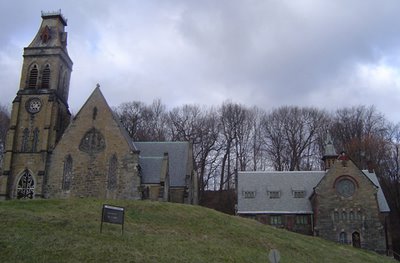 The 137-year-old Woodside Presbyterian Church on Mill Street at Erie Street in South Troy is for sale. The price was not disclosed. Buyers would be required to maintain the historic characteristics and there would be a right of first refusal clause so the founding families would have the first option to buy if it ever goes on sale again. The church was abandoned by its dwindling congregation in 2003 after the city building inspector declared it unsafe to occupy.
The 137-year-old Woodside Presbyterian Church on Mill Street at Erie Street in South Troy is for sale. The price was not disclosed. Buyers would be required to maintain the historic characteristics and there would be a right of first refusal clause so the founding families would have the first option to buy if it ever goes on sale again. The church was abandoned by its dwindling congregation in 2003 after the city building inspector declared it unsafe to occupy.
Out-of-state heirs of the church's founder have met with public officials and historic preservationists about a strategy to save the 1868 church from the wrecking ball. The cost of maintaining the building has become a financial burden. The 1869 E & G.G. Hook pipe organ was dismantled and removed from the church after a state court ruled that the historic organ was the property of the 72-church Albany Presbytery, the successor to the local congregation that abandoned the church in 2003. The organ was sold to a Mennonite Church in Kansas City at a reported price of $40,000.
The church was built by Henry Burden on a five-acre site donated by Erastus Corning but not after a tumultuous start.
In 1841, Burden's Troy Iron and Nail Factory sued Corning's Albany Iron Works for infringement on a patent to a machine that produced hook-headed railroad spikes, critical to the expansion of the growing rail industry. It would become the longest running patent suit of its day until it was resolved in the early 1860s. It came before the U.S. Supreme Court three times.
During that time, Corning, whose plant on the north bank of the Wynants Kill*, directly across from Burden's, sued his rival for tampering with water rights. Ultimately, both lawsuits were settled in the 1860s; the patent case in favor of Burden and the water dispute for Corning. It is believed that the construction of the church was part of a settlement. [*Note: A "kill" is a term used mostly in New York State to describe a stream, creek, or tributary. Its origin is Dutch, and the Dutch settled the area along the Hudson River valley.]
A Sunday school was organized in Mechanics' Hall on the south side of Mill Street in early 1866. The Troy Presbytery then organized the South Presbyterian Church of Troy there with 29 members. The name was later changed to Woodside Presbyterian Church.
The erection of the handsomely-finished stone church and chapel was begun in May of 1868 and the cornerstone was laid on September 16th. The first services were held in the chapel in June of 1869 and it was dedicated on July 15th. The expenditures made for the erection and furniture of the building were not less than $75,000.
A tablet set in the interior side of the south wall of the edifice displays the following inscription:
"Woodside Memorial Church, dedicated to the service of the Triune God, has been erected to the memory of Helen BURDEN by her husband, Henry BURDEN, in accordance with her long-cherished and earnest desire, 1869."The following inscription is lettered on a tablet on one of its walls:
"Woodside Chapel. Erected A. D. 1883, by Margaret E. PROUDFIT, James A. BURDEN, I Townsend BURDEN, in memory of their children."After the death of Henry Burden on January 19th, 1871, his surviving children erected to his memory the attractive manse on the west side of the church seen in the photo on the right.
If you liked this post, consider these:
Old First Church of Bennington
St. Joseph's Catholic Church Of Albany
Ukranian Catholic Church of Cohoes
First Church Of Albany
What Does Your God Look Like?
Considering that I'm an agnostic, my fascination with churches seems odd. I find their architecture beautiful. I wish they were grocery stores, restaurants, or gas stations so I could get some use out of them instead of just driving by!

1 comment:
I attended here briefly in 1974 as a HVCC student. Sad to see the organ go, but at least it's being used. It was barely alive back then. The interior is American Chestnut, or something like that. I think it's extinct now. Also of interest is the full carillon in the tower. 13 bells? And the clock is a wind-up clock. They quit winding it when the church members got too old to crank the weights up from the basement of the church to the tower. It range at least every hour. There are also levers to play the bells. I toured the tower, but I don't think I rang any bells. Sure wish I had now!
Post a Comment